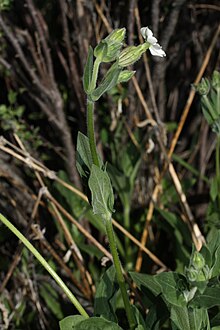Silene latifolia
| Silene latifolia | |
|---|---|

| |
| Scientific classification | |
| Kingdom: | Plantae |
| Clade: | Tracheophytes |
| Clade: | Angiosperms |
| Clade: | Eudicots |
| Order: | Caryophyllales |
| Family: | Caryophyllaceae |
| Genus: | Silene |
| Species: | S. latifolia
|
| Binomial name | |
| Silene latifolia | |
| Synonyms[1] | |
| |
Silene latifolia, commonly known as white campion, is a dioecious flowering plant in the family Caryophyllaceae, native to most of Europe, Western Asia and northern Africa. It is a herbaceous annual, occasionally biennial or a short-lived perennial plant, growing to between 40–80 centimetres tall. It is also known in the US as bladder campion[2] but should not be confused with Silene vulgaris, which is more generally called bladder campion.
The appearance depends on the age of the plant; when young they form a basal rosette of oval to lanceolate leaves 4–10 cm long, and when they get older, forked stems grow from these, with leaves in opposite pairs. The flowers grow in clusters at the tops of the stems, 2.5–3 cm diameter, with a distinctive inflated calyx and five white petals, each petal deeply notched; flowering lasts from late spring to early autumn. The entire plant is densely hairy. Occasional plants with pink flowers are usually hybrids with red campion (Silene dioica).
Habitat and occurrence
[edit]White campion grows in most open habitats, particularly wasteland and fields, most commonly on neutral to alkaline soils. Despite the wide array of conditions in which campion can thrive, it prefers sunny areas that have rich and well-drained soil.[3] An example ecoregion of occurrence is in the Sarmatic mixed forests.[4]
It is also named the Grave Flower or Flower of the Dead in parts of England as they are seen often growing on gravesites and around tombstones.
It is naturalised in North America, being found in most of the United States, the greatest concentrations of the plant can be found in the north-central and northeastern sections of the country.[5] S. latifolia is thought to have arrived in North America as a component of ship ballast.
Inbreeding avoidance
[edit]In S. latifolia, outbred male offspring were found to sire significantly more progeny than inbred male offspring.[6] This study indicated the occurrence of inbreeding depression in male plants under natural conditions. In female plants, inbreeding depression significantly affects vegetative growth, age at first flowering and total fitness.[7]
Post-pollination selection occurs in S. latifolia.[7] After multiple-donor pollination, it was found that pollen or embryo selection likely reduces the occurrence of inbred progeny.[7]
Sex Chromosomes
[edit]S. latifolia is a dioecious plant, which means that they have male and female individuals. The sex of S. latifolia is determined by sex chromosomes. XX individuals are female, XY individuals are male. The Y chromosome is larger than the X chromosome, and the sex chromosomes are the largest chromosome in S. latifolia.[8]
Sex chromosomes of S. latifolia originated from a pair of autosomes that evolved sex determining genes and stopped recombining. Recombination suppression between X and Y chromosome in S. latifolia has been found and degeneration of the Y chromosome has started.[9] Sex-linked gene mapping shows three evolutionary strata where recombination stopped through three different major events.[10]
Recombination of the central region of the X chromosome has also been found to be suppressed. Incomplete dosage compensation is found in the X chromosome.[11]
Use among Native Americans
[edit]The Ojibwe use an infusion of the alba subspecies as a medicine.[12]
Susceptibility to disease
[edit]Silene latifolia is afflicted by the fungal pathogen Microbotryum violaceum, which acts as a sterilizing sexually transmitted infection in this species.
-
Each petal is deeply notched
-
Silene latifolia – MHNT
-
Silene latifolia in an open area that has a lot of exposure to sunlight
References
[edit]- ^ "Plants Of the World Online".
- ^ USDA, NRCS (n.d.). "Silene latifolia". The PLANTS Database (plants.usda.gov). Greensboro, North Carolina: National Plant Data Team. Retrieved 14 November 2015.
- ^ Connecticut Botanical Society
- ^ C.Michael Hogan. 2011. "Sarmatic mixed forests". Topic ed. Sidney Draggan. Ed.-in-chief Cutler J.Cleveland. Encyclopedia of Earth. Environmental Information Coalition, National Council for Science and the Environment
- ^ Richard H. Uva, Joseph C. Neal and Joseph M. Ditomaso, Weeds of The Northeast, (Ithaca, NY: Cornell University Press, 1997), Pp. 198-199
- ^ Austerlitz F, Gleiser G, Teixeira S, Bernasconi G (2012). "The effects of inbreeding, genetic dissimilarity and phenotype on male reproductive success in a dioecious plant". Proc. Biol. Sci. 279 (1726): 91–100. doi:10.1098/rspb.2011.0652. PMC 3223646. PMID 21561968.
- ^ a b c Teixeira S, Foerster K, Bernasconi G (2009). "Evidence for inbreeding depression and post-pollination selection against inbreeding in the dioecious plant Silene latifolia". Heredity (Edinb). 102 (2): 101–12. doi:10.1038/hdy.2008.86. PMID 18698334.
- ^ Hobza, Roman; Lengerova, Martina; Cernohorska, Halina; Rubes, Jiri; Vyskot, Boris (2004-04-01). "FAST-FISH with laser beam microdissected DOP-PCR probe distinguishes the sex chromosomes of Silene latifolia". Chromosome Research. 12 (3): 245–250. doi:10.1023/B:CHRO.0000021929.97208.1c. ISSN 1573-6849. PMID 15125638. S2CID 21488862.
- ^ Papadopulos, Alexander S. T.; Chester, Michael; Ridout, Kate; Filatov, Dmitry A. (2015-10-20). "Rapid Y degeneration and dosage compensation in plant sex chromosomes". Proceedings of the National Academy of Sciences. 112 (42): 13021–13026. Bibcode:2015PNAS..11213021P. doi:10.1073/pnas.1508454112. ISSN 0027-8424. PMC 4620866. PMID 26438872.
- ^ Bergero, Roberta; Forrest, Alan; Kamau, Esther; Charlesworth, Deborah (April 2007). "Evolutionary Strata on the X Chromosomes of the Dioecious Plant Silene latifolia: Evidence From New Sex-Linked Genes". Genetics. 175 (4): 1945–1954. doi:10.1534/genetics.106.070110. ISSN 0016-6731. PMC 1855140. PMID 17287532.
- ^ Yue, Jingjing; Krasovec, Marc; Kazama, Yusuke; Zhang, Xingtan; Xie, Wangyang; Zhang, Shencheng; Xu, Xiuming; Kan, Baolin; Ming, Ray; Filatov, Dmitry A. (2023-06-19). "The origin and evolution of sex chromosomes, revealed by sequencing of the Silene latifolia female genome". Current Biology. 33 (12): 2504–2514.e3. doi:10.1016/j.cub.2023.05.046. ISSN 0960-9822. PMID 37290443.
- ^ Smith, Huron H. 1932 Ethnobotany of the Ojibwe Indians. Bulletin of the Public Museum of Milwaukee 4:327-525 (p. 361)



